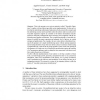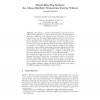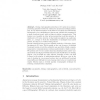EUROCRYPT
2004
Springer
14 years 5 months ago
2004
Springer
An aggregate signature scheme (recently proposed by Boneh, Gentry, Lynn, and Shacham) is a method for combining n signatures from n different signers on n different messages int...
EUROCRYPT
2004
Springer
14 years 5 months ago
2004
Springer
Informally, an obfuscator O is an efficient, probabilistic “compiler” that transforms a program P into a new program O(P) with the same functionality as P, but such that O(P)...
EUROCRYPT
2004
Springer
14 years 5 months ago
2004
Springer
Denoting by P = [k]G the elliptic-curve double-and-add multiplication of a public base point G by a secret k, we show that allowing an adversary access to the projective representa...
EUROCRYPT
2004
Springer
14 years 5 months ago
2004
Springer
In trying to provide formal evidence that composition has security increasing properties, we ask if the composition of non-adaptively secure permutation generators necessarily pro...
EUROCRYPT
2004
Springer
14 years 5 months ago
2004
Springer
We revisit the following open problem in information-theoretic cryptography: Does the communication complexity of unconditionally secure computation depend on the computational com...
EUROCRYPT
2004
Springer
14 years 5 months ago
2004
Springer
Abstract. This work presents a new privacy primitive called “Traceable Signatures”, together with an efficient provably secure implementation. To this end, we develop the unde...
EUROCRYPT
2004
Springer
14 years 5 months ago
2004
Springer
EUROCRYPT
2004
Springer
14 years 5 months ago
2004
Springer
Abstract. Dining cryptographers networks (or DC-nets) are a privacypreserving primitive devised by Chaum for anonymous message publication. A very attractive feature of the basic D...
EUROCRYPT
2004
Springer
14 years 5 months ago
2004
Springer
It is well-known that n players connected only by pairwise secure channels can achieve multi-party computation secure against an active adversary if and only if – t < n/2 of t...
EUROCRYPT
2004
Springer
14 years 5 months ago
2004
Springer
Abstract. In the bounded-storage model (BSM) for information-theoretically secure encryption and key-agreement one uses a random string R whose length t is greater than the assumed...






